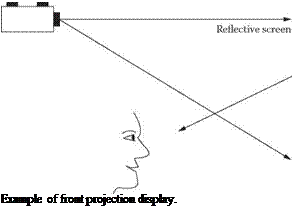 |
Front projection displays (Figure 4.18) are typically less expensive to set up than rear projection display systems. However, the technology has a few drawbacks that need to be considered. When front projecting, the operator is prohibited from going too close to the display as this will shield the projected image from other viewers. Front projection display needs dimmed lighting to achieve a decent image contrast. The rationale for this is that because the screen itself reflects all light, the ambient room
figure 4.18
light will be reflected as well. This effect ‘washes out’ the image and gives it a kind of ‘milky’ appearance.
Recently, new types of projection screens have been introduced that somehow preserve the contrast better than the traditional white screens. These new screens are either grey/dark tinted to reduce reflection or they include an integrated optical lens system. An advantage of an integrated optical lens system is that this reflects light from some directions and absorbs light from other directions. Among these ‘optical front projection screens’ are the dnp Supernova screen (from dnp Denmark) and the Arisawa Nexy BSB screen (Arisawa Mfg. Co., Ltd).
It should be noted that when the projector specification sheet states a certain contrast ratio, it normally refers to a completely darkened room. But if there is lighting in the room, the screen’s reflection properties will normally have a higher influence on the image contrast ratio than the projector’s ‘theoretical contrast ratio’. A single projector typically has an image pixel resolution from 800 x 600 to 1600 x 1200 (1920 x 1080). Depending on the images being shown on the VDU and the size of the VDU, it might be adequate to use only one projector for the VDU.
However, it is often necessary to combine a number of projectors to form the required image. The projectors will typically be aligned in an array in horizontal and vertical rows. By doing this, the overall image brightness and resolution is improved. In principle, there are two methods of projector tiling: (1) soft edge projection, where each individual projected image partly overlaps neighbouring images, and brightness is reduced in the edge region; and (2) hard edge projection, where each individual projected image is aligned side-by-side with the neighbour images.



